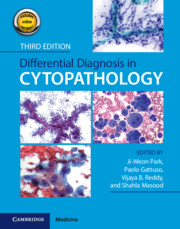Book contents
- Differential Diagnosis in Cytopathology
- Differential Diagnosis in Cytopathology
- Copyright page
- Dedication
- Contents
- Contributors
- Preface
- 1 The Pap Smear
- 2 Exfoliative Pulmonary Cytology
- 3 Body Cavity Fluids
- 4 Gastrointestinal Tract
- 5 Urinary Cytology
- 6 Cerebrospinal Fluid and Intraocular Cytology
- 7 Cytopathology of Central Nervous System
- 8 Fine-Needle Aspiration of Thyroid Gland
- 9 Parathyroid Gland, Head, and Neck
- 10 Salivary Glands
- 11 Cytopathology of the Breast
- 12 Fine-Needle Aspiration of Lymph Nodes
- 13 Fine-Needle Aspiration of Lung, Pleura, and Mediastinum
- 14 Fine-Needle Aspiration of Liver
- 15 Fine-Needle Aspiration of the Pancreas
- 16 Fine-Needle Aspiration of Soft Tissue and Bone
- 17 Fine-Needle Aspiration of the Kidney and Adrenal Gland
- 18 Cytology of the Gonads
- 19 Fine-Needle Aspiration Cytology of Tumors of Unknown Origin
- Index
- References
14 - Fine-Needle Aspiration of Liver
Published online by Cambridge University Press: 05 March 2021
- Differential Diagnosis in Cytopathology
- Differential Diagnosis in Cytopathology
- Copyright page
- Dedication
- Contents
- Contributors
- Preface
- 1 The Pap Smear
- 2 Exfoliative Pulmonary Cytology
- 3 Body Cavity Fluids
- 4 Gastrointestinal Tract
- 5 Urinary Cytology
- 6 Cerebrospinal Fluid and Intraocular Cytology
- 7 Cytopathology of Central Nervous System
- 8 Fine-Needle Aspiration of Thyroid Gland
- 9 Parathyroid Gland, Head, and Neck
- 10 Salivary Glands
- 11 Cytopathology of the Breast
- 12 Fine-Needle Aspiration of Lymph Nodes
- 13 Fine-Needle Aspiration of Lung, Pleura, and Mediastinum
- 14 Fine-Needle Aspiration of Liver
- 15 Fine-Needle Aspiration of the Pancreas
- 16 Fine-Needle Aspiration of Soft Tissue and Bone
- 17 Fine-Needle Aspiration of the Kidney and Adrenal Gland
- 18 Cytology of the Gonads
- 19 Fine-Needle Aspiration Cytology of Tumors of Unknown Origin
- Index
- References
Summary
Liver biopsy is indicated in two general clinical scenarios. The first scenario occurs when a diffuse liver disease is suspected, typically after a patient has abnormal liver function tests. In this instance, a nontargeted or random biopsy is performed to obtain a sample of tissue for determination of severity of diffuse liver disease. Random biopsy may also be used to monitor effectiveness of treatment, or for post-transplant monitoring. As these cases require histologic assessment, cytologic assessment is generally not indicated. Conversely, when a targeted liver biopsy is ordered to diagnose a focal liver mass or abnormality that cannot otherwise be characterized, cytology is frequently utilized as a first line diagnostic test.
- Type
- Chapter
- Information
- Differential Diagnosis in Cytopathology , pp. 463 - 484Publisher: Cambridge University PressPrint publication year: 2021



